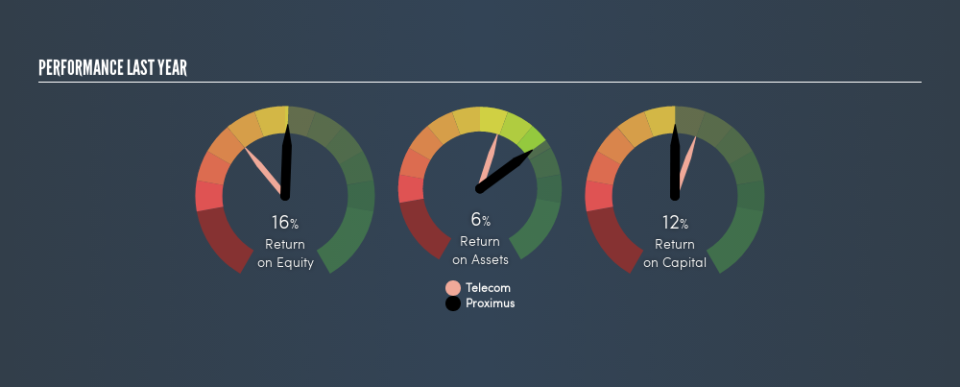What Can We Make Of Proximus PLC’s (EBR:PROX) High Return On Capital?

Want to participate in a short research study? Help shape the future of investing tools and you could win a $250 gift card!
Today we are going to look at Proximus PLC (EBR:PROX) to see whether it might be an attractive investment prospect. Specifically, we're going to calculate its Return On Capital Employed (ROCE), in the hopes of getting some insight into the business.
First up, we'll look at what ROCE is and how we calculate it. Second, we'll look at its ROCE compared to similar companies. Finally, we'll look at how its current liabilities affect its ROCE.
Understanding Return On Capital Employed (ROCE)
ROCE measures the amount of pre-tax profits a company can generate from the capital employed in its business. Generally speaking a higher ROCE is better. Ultimately, it is a useful but imperfect metric. Renowned investment researcher Michael Mauboussin has suggested that a high ROCE can indicate that 'one dollar invested in the company generates value of more than one dollar'.
How Do You Calculate Return On Capital Employed?
The formula for calculating the return on capital employed is:
Return on Capital Employed = Earnings Before Interest and Tax (EBIT) ÷ (Total Assets - Current Liabilities)
Or for Proximus:
0.12 = €813m ÷ (€9.0b - €2.2b) (Based on the trailing twelve months to March 2019.)
Therefore, Proximus has an ROCE of 12%.
Check out our latest analysis for Proximus
Is Proximus's ROCE Good?
ROCE is commonly used for comparing the performance of similar businesses. In our analysis, Proximus's ROCE is meaningfully higher than the 7.9% average in the Telecom industry. We would consider this a positive, as it suggests it is using capital more effectively than other similar companies. Independently of how Proximus compares to its industry, its ROCE in absolute terms appears decent, and the company may be worthy of closer investigation.
When considering ROCE, bear in mind that it reflects the past and does not necessarily predict the future. ROCE can be misleading for companies in cyclical industries, with returns looking impressive during the boom times, but very weak during the busts. This is because ROCE only looks at one year, instead of considering returns across a whole cycle. Since the future is so important for investors, you should check out our free report on analyst forecasts for Proximus.
Do Proximus's Current Liabilities Skew Its ROCE?
Liabilities, such as supplier bills and bank overdrafts, are referred to as current liabilities if they need to be paid within 12 months. Due to the way ROCE is calculated, a high level of current liabilities makes a company look as though it has less capital employed, and thus can (sometimes unfairly) boost the ROCE. To counteract this, we check if a company has high current liabilities, relative to its total assets.
Proximus has total liabilities of €2.2b and total assets of €9.0b. Therefore its current liabilities are equivalent to approximately 25% of its total assets. Low current liabilities are not boosting the ROCE too much.
What We Can Learn From Proximus's ROCE
This is good to see, and with a sound ROCE, Proximus could be worth a closer look. Proximus looks strong on this analysis, but there are plenty of other companies that could be a good opportunity . Here is a free list of companies growing earnings rapidly.
For those who like to find winning investments this free list of growing companies with recent insider purchasing, could be just the ticket.
We aim to bring you long-term focused research analysis driven by fundamental data. Note that our analysis may not factor in the latest price-sensitive company announcements or qualitative material.
If you spot an error that warrants correction, please contact the editor at editorial-team@simplywallst.com. This article by Simply Wall St is general in nature. It does not constitute a recommendation to buy or sell any stock, and does not take account of your objectives, or your financial situation. Simply Wall St has no position in the stocks mentioned. Thank you for reading.

